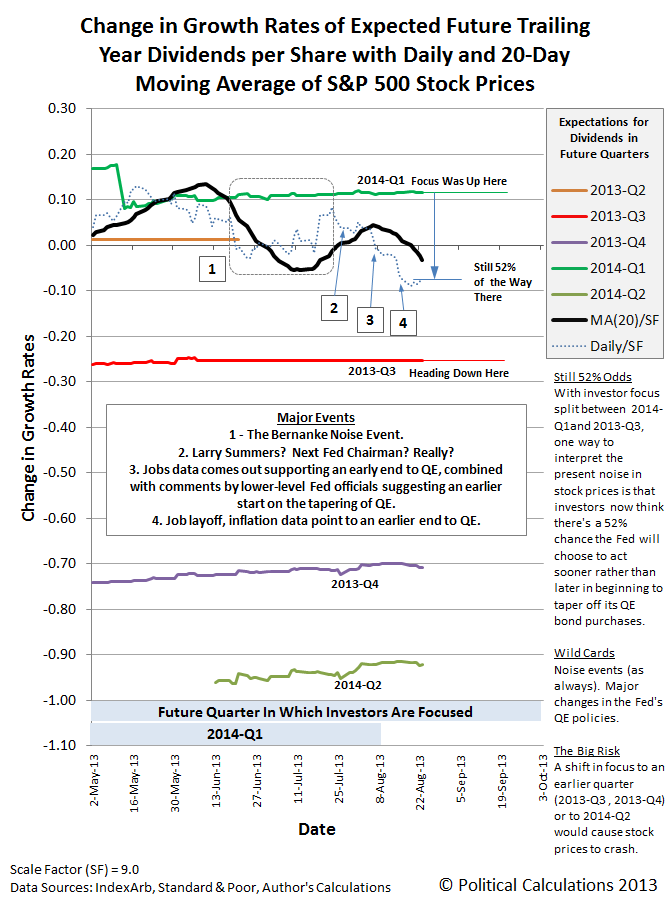Now that the BEA has released its massive revision of the United States' Gross Domestic Product, we're going to put our Keynesian-style GDP multiplier tool to the test. Will it still be able to accurately predict what a future quarter's nominal GDP will be for the current U.S. economy based only based only on a previous quarter's GDP and a handful of fiscal and monetary policy GDP input shocks? Or will it fold up like the cheap suits worn by Keynesian-style economists?
To do this analysis, we'll be projecting the future value for nominal GDP from the starting point of the fourth quarter of 2012. This is the final quarter preceding major changes in the U.S. government's policies for taxes and spending, which makes it an ideal zero point in time from which to consider the impact of these shocks to the economy. The table below presents the values we'll be using in this analysis.
| Changes in Fiscal or Monetary Policy Drivers Since 2012-Q4 |
| Fiscal or Monetary Policy Driver | Total Through 2013-Q1 | Total Through 2013-Q2 |
| Change in Expected Tax Collections | +$56.3 billion | +$112.6 billion |
| Change in Government Spending | -$26.6 billion | -$29.1 billion |
| Amount of Quantitative Easing | +$295.0 billion | +$572.0 billion |
Now it's time to do the math! We've entered the data that applies through the first quarter of 2013 into the tool below, which you'll need to change to the values that apply for 2013-Q2 to project the value of GDP for that quarter.
But before you go any farther, if you're reading this article on a site that republishes our RSS news feed, please click here to access a working version of this tool at our site, where it will also be properly formatted (we're looking at you, feedly - we speak CSS, you should too!...)
What we find is that with the data for 2013-Q1, for the Keynesian-style GDP multipliers that apply for fiscal and monetary policy, our tool would predict that nominal GDP would be $16,530.4 billion. That compares with the $16,535.3 billion actually recorded by the BEA for the nation's GDP in the first quarter of 2013, which means that our tool would appear to have underpredicted GDP in 2013-Q1 by $4.9 billion, an error of 0.03%.
After substituting in the data for 2013-Q2, with the exact same GDP multipliers, our tool predicts that nominal GDP would be $16,637.0 billion. The BEA's first estimate of GDP for the second quarter of 2013 is actually $16,633.4 billion, as our tool appears to have overpredicted GDP in 2013-Q2 by $4.4 billion, also an error that rounds to 0.03%.
The BEA will not finalize its estimate of GDP for 2013-Q2 until September 2013, so the actual difference between our tool's projection and the official figure will be subject to change until then. Regardless, from the data we do have, it appears that our tool can predict future nominal GDP levels for the current economy with a surprising degree of accuracy.
Update 14 September 2013: It occurs to us that a picture might be worth 1000 words here. Here's a chart illustrating how the puzzle pieces fit together, based upon the BEA's second estimate of GDP for 2013-Q2 (the third estimate will come out near the end of September 2013):
It is pretty clear from these results that if not for the Fed's quantitative easing programs, the U.S. economy would have contracted in recession during these quarters. You can consider the impact to what the U.S.' GDP would be by zeroing out this value in our tool above.
These results also demonstrate that monetary policy can remain highly effective even if basic interest rates are at or near the zero level. We'll discuss the mechanisms by which we think the Fed's quantitative easing programs affect the nation's economy in an upcoming post.
In the meantime, you can take advantage of our tool to get a sense of the extent to which the federal government's tax hikes and spending cuts in 2013 are actually affecting the nation's GDP by alternately zeroing out these figures. One thing that you'll find is that over 90% of the negative drag on GDP may be attributed to the tax hikes that took effect in 2013. Less than 10% may be attributed to reductions in government spending at all levels in the U.S.
Finally, if you really want to play the "what if" game, try combining government spending cuts with modest tax cuts in our tool above. One may wonder why today's politicians aren't discussing implementing this particular combination of fiscal policies.
About the Numbers in the Tool
GDP and Government Spending: The GDP ($16,420.3 billion) for our starting quarter (2012-Q4) was taken from the BEA's massive revision of GDP from 1929 through the first quarter of 2013, as were the numbers we've indicated for the total change in government spending from that starting quarter (-$26.6 billion for 2013-Q1 and -$29.1 billion for 2013-Q2). Most of the reduction in government spending occurred at the federal government level, with the balance being recorded for state and local governments.
We should also note that total government spending appears to have only fallen by $2.5 billion from 2013-Q1 to 2013-Q2 in the BEA's initial estimate for the more recent quarter, all of which occurred at the federal government level. We anticipate that this number will change as the BEA updates its estimate of government spending for 2013-Q2.
2013's Tax Hikes
 The total for the change in the amount of taxes in the U.S. is based on the fiscal cliff tax deal of 3 January 2013, which increased the Social Security payroll tax by 2%, as well as increased the tax rates paid by high income earners and also the tax rates for investments.
The total for the change in the amount of taxes in the U.S. is based on the fiscal cliff tax deal of 3 January 2013, which increased the Social Security payroll tax by 2%, as well as increased the tax rates paid by high income earners and also the tax rates for investments.
Social Security Payroll Tax Hike: Here, we estimated the additional amount that President Obama expects to collect through Social Security's combined employer-employee payroll tax of 12.4% in 2013 (as indicated by Table 2.4 of President Obama's FY2014 budget proposal) compared to what would have been collected under 2012's combined tax rate of 10.4%, arriving at a figure of $108.6 billion for the year, for which we assumed that one-fourth ($27.16 billion) would be collected in the first quarter of 2013.
Obamacare Taxes: We also took into account the tax increases that went into effect on investment income and upon high income earners as part of the Patient Protection and Affordable Care Act, which are expected to total $36 billion in 2013, one-fourth ($9 billion) of which we assumed was incurred in the first quarter.
Fiscal Cliff Income and Investment Tax Hikes: The remaining portion of tax increases taking effect were a direct outcome of the increases in the top income tax rates and upon investment income mandated as part of the fiscal cliff tax deal at the beginning of 2013, where a static analysis indicates that the $80.6 billion more in taxes will be collected in 2013, one-fourth ($20.15 billion) of which might be applied to the first quarter of the year.
Combined, these values total up to a tax bill for Americans that's $225.2 billion higher for Americans in 2013 than in 2012, which works out to be approximately $56.3 billion higher for just 2013-Q1. To come up with the cumulative total of expected changes in tax collections from 2012-Q4 through 2013-Q2, we simply multiplied this quarterly change by a factor of 2.
About the Multipliers
 We featured a discussion of the fiscal multipliers for government spending and tax policies in our previous discussion of Spain's disastrous economic choices of 2012. At present, we're simply assuming that the fiscal multiplier for the Fed's quantitative easing programs is 1.0, in the absence of data that might contradict that figure. As yet, there really isn't any data to contradict this estimate.
We featured a discussion of the fiscal multipliers for government spending and tax policies in our previous discussion of Spain's disastrous economic choices of 2012. At present, we're simply assuming that the fiscal multiplier for the Fed's quantitative easing programs is 1.0, in the absence of data that might contradict that figure. As yet, there really isn't any data to contradict this estimate.
Quantitative Easing
Our estimates of the cumulative amount of quantitative easing being provided by the Federal Reserve through the first and second quarters of 2013 were determined by finding the change in the total assets held by the Fed with respect to their holdings at the end of 2012. That worked out to be $295.0 billion through 2013-Q1 and $572.0 billion through 2013-Q2.
Data Sources
Board of Governors of the Federal Reserve System. All Federal Reserve Banks - Total Assets, Eliminations from Consolidation. [Text Document]. Accessed 11 August 2013.
Cloyne, James. What Are the Effects of Tax Changes in the United Kingdom? New Evidence from a Narrative Evaluation. [PDF Document]. CESIFO Working Paper No. 3433. April 2011.
Owyang, Michael T., Ramey, Valerie A. and Zubairy, Sarah. Are Government Spending Multipliers Greater During Periods of Slack? Evidence from 20th Century Historical Data. [PDF Document]. Federal Reserve Bank of St. Louis. Economic Research Division. Working Paper 2013-004A. January 2013.
Romer, Christina D. and Romer, David H. The Macroeconomic Effects of Tax Changes: Estimates Based on a New Measure of Fiscal Shocks. [PDF Document]. March 2007.
U.S. Bureau of Economic Analysis. National Income and Product Accounts, Gross Domestic Product: Second Quarter 2013 (Advance Estimate), Comprehensive Revision: 1929 through First Quarter 2013. [Text Document]. 31 July 2013.



















